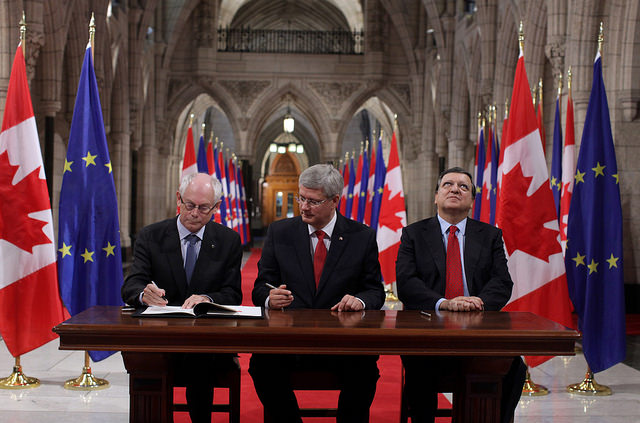 When official treaty negotiations end, unofficial negotiations begin. Changes made during “legal scrubbing” can turn the original deal on its head as our text-as-data analysis shows.
When official treaty negotiations end, unofficial negotiations begin. Changes made during “legal scrubbing” can turn the original deal on its head as our text-as-data analysis shows.
(Picture: Herman Van Rompuy, EU-Canada Summit 26.09.2014 Flickr)
After any major treaty negotiation is concluded the final text of the agreement will be vetted by a group of lawyers of the state parties. This procedure is commonly referred to as “legal scrubbing” and can result in minor changes to the treaty text. What happened during the legal scrubbing process of the Canada – EU Comprehensive Economic and Trade Agreement (CETA), however, is something out of the ordinary: entire articles were added and the controversial investor-state arbitration architecture was replaced by a novel investment court system. To unravel what really happened during the legal scrubbing phase, we have developed a novel text-as-data tool that traces textual differences across international investment agreements.
Our research project, mappinginvestmenttreaties.com, tracks the textual similarity of over 1600 international investment agreements. Using an approach) akin to that developed in plagiarism detection software, we split treaties into their consecutive 5-character components and calculate the Jaccard distance of overlapping components between a given treaty pair. Furthermore, for a selection of agreements, we have implemented a diff comparison that allows us to visually compare which words differ between otherwise similar treaty provisions.
In the case of the CETA investment chapter, we were surprised to find that the text released at the end of negotiations in 2014 and the version that came out of legal scrubbing in February 2016 diverge by 19%. To get a sense of the magnitude of this percentage, 19% was also the textual difference that we found while comparing the recently concluded Transpacific Partnership’s (TPP) investment chapter with its most similar preceding agreement, the United States-Colombia Free Trade Agreement, signed in 2006. The latter case, however, involved two separate treaties whereas the former instance concerns two versions of the very same agreement.
While conducting an in-depth comparison of the two CETA versions, we found that only a mere fraction of the 19% divergence is due to legal scrubbing in the strict sense: e.g. simplifying and clarifying language (e.g. CETA 2014: “Neither Party may impose…” in CETA 2016: “A Party shall not impose…” in Article 8.5 Performance Requirements), turning singular into plural, fine-tuning the numbering of articles etc. The vast majority of changes instead consist of material alterations of the treaty text – a de facto renegotiation. A new Article 8.9 was added to “reaffirm [the Parties’] right to regulate within their territories to achieve legitimate policy objectives”. In addition, the dispute settlement architecture was completely redesigned (Articles 8.27-8.29) and new clauses on the disclosure of third party funding and adjudicator ethics were inserted (Articles 8.26 & 8.30).
A bit of background is needed to understand the important ramifications of these changes. After the Doha Round negotiations deadlocked at the WTO, countries began signing ever more extensive preferential trade and investment agreements (PTIAs) among themselves. The biggest such agreement was concluded in February 2016: the Transpacific Partnership. To counter-balance ever deeper economic cooperation in the Pacific, the EU has been keen to negotiate an even bigger trade deal, the Transatlantic Trade and Investment Partnership (T-TIP), with the United States. As the T-TIP’s smaller cousin, CETA has been widely seen as the EU’s testing ground for its negotiations with the U.S.
In September 2014, the negotiations of CETA were concluded and its legal vetting process began. Around the same time, public protest peaked against investor-state arbitration, a mechanism that allows private investors to initiate claims against governments to redress treaty violations. Investor-state arbitration is included in thousands of bilateral investment treaties and was also to be part of CETA and T-TIP talks. The EU sought to address public criticism by inserting a reformed version of investor-state arbitration into the September 2014 version of CETA.
Public opposition against investor-state arbitration, however, did not subside. To further appease critics, the EU Commission thus proposed the creation of a permanent investment court system in September 2015, which would replace ad hoc investor-state arbitration. This court system would first start on the bilateral level, but was eventually to be transformed into a multilateral superstructure. The EU Commission integrated the investment court proposal into its negotiation position for T-TIP. The United States, however, has so far shown little enthusiasm for the idea of an investment court having itself never lost a case in investor-state arbitration.
The EU thus had a problem: faced with tough resistance from the U.S. against the investment court system, which had become the flagship project for the EU to win over domestic T-TIP critics, the EU needed leverage. CETA could provide such leverage. If Canada, as the U.S. closest economic partner, could be convinced of the merits of an investment court, CETA could put pressure on the United States to do the same. Yet, CETA negotiations had already been concluded without an investment court. So what was the EU to do?
The EU managed to turn what had begun as legal scrubbing into a de facto effort to renegotiate CETA by the fall of 2015. The change of government in Canada played into the hands of the EU as the new Prime Minister Justin Trudeau was open to revisit the document negotiated by his Conservative predecessor, Stephen Harper. On February 29, 2016 the finalized text of CETA post “legal scrubbing” was revealed. As the EU press release stated: “[f]ollowing the legal revision of the text, […] [a]ll the main elements of the EU’s new approach on investment, as outlined in the EU’s TTIP proposal of November 2015 and contained in the recently concluded EU-Vietnam free trade agreement, have been included in the finalised CETA text.” Under the veil of legal vetting, a new version of the CETA investment chapter had thus been negotiated.
So what is the take-away message? On the one hand, the EU has played its cards smartly, integrating its updated investment policy preferences into an already finalized text and thereby improving its negotiation position vis-à-vis the United States. On the other hand, it is also worrying that procedures formally labeled as mere legal scrubbing can result in a de facto renegotiation of an already finalized treaty text. The negotiation process of CETA thus points to the added value of textual analysis to unpack the legal scrubbing process and to make changes between treaty versions visible and analyzable.
This post was originally posted on the-plot.org
 Although devloped countries were the main architects of the BIT universe, some treaty features have a distinctly developing country handwriting as our analysis of African BIT innovators suggests.
Although devloped countries were the main architects of the BIT universe, some treaty features have a distinctly developing country handwriting as our analysis of African BIT innovators suggests.